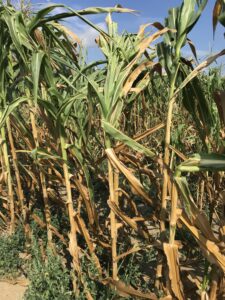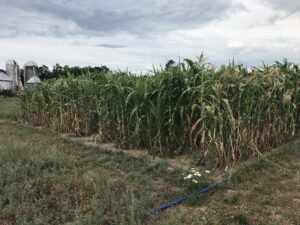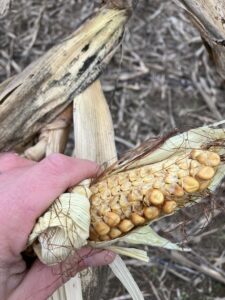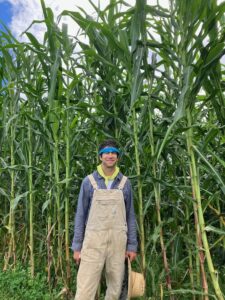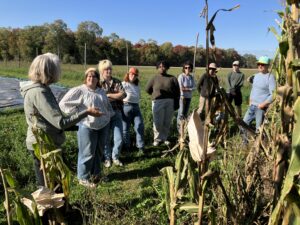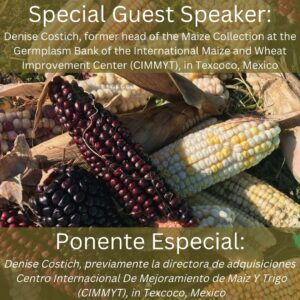Final report for FNE22-028
Project Information
There is a growing market for tortillas and heritage varieties of corn to produce them. Transport of this ingredient from its cultivation origin is traditionally cost prohibitive. The objective of these trials was to determine whether landrace varieties of corn from Mexico and Central America that are traditionally used for producing tortillas could be grown in New York's Hudson Valley.
Varieties of corn were chosen from the CIMMYT Seed Bank in Texcoco, Mexico based on their traditional use for tortilla production, short growing period, and ideally northern latitude to try and offset photo-period sensitivity.
19 varieties were chosen for the first season, and one control (Wapsie Valley) was compared because though it is not a traditional variety used for tortillas, the local tortilla industry has been using it successfully as a substitute due to its attributes and cultivation in the United States. All varieties were grown in adjacent plots with identical conditions with regard to soil type, fertility regimen, and irrigation.
After the first season the 10 most successful varieties were chosen for a second round.
By the end of the second season a clear winner was identified. The main attributes that supported this ranking was resistance to lodging in summer wind storms, large full ears, drying down at the end of the season, and excellent seed viability after harvest.
Results were shared through farm tours and demostrations.
- During season one cultivars from the CIMMYT seed bank will be identified, grown out in the field, and tested for viability. In other words whether they produce viable kernels.
- During season two the most promising varieties will be grown out and effort will be put into developing seed stock and determining the effect of different agricultural methods on production capacity. Local tortillerias and chefs will be given samples of maize to test against currently used corn.
- Results will be published and shared during each of the two seasons via press releases, interviews, and workshops for local farmers, with an emphasis on Latin American farmers. I will share these results at a our regional Latinx Farmers Conference organized by Cornell University in October, 2025.
For millennia populations in Latin America have depended on the maize tortilla as a staple source of nutrition. There are at least 60 cultivars in Mexico alone, and thousands of distinct varieties which have been selected and bred by indigenous populations for their agricultural, nutritional, and culinary properties. Seed coat hardness, starch to protein ratios, elasticity, and cohesion are a few characteristics1 that play a role in tortilla elaboration, characteristics that most maize varieties developed in the United States do not possess.
To accommodate, processors have invented work-arounds. One involves the expensive importation of traditional maize varieties. With historical transportation costs, and recently rising supply-chain issues, one northeast tortilla producer that was interviewed reported that using traditional imported corn varieties added thousands of dollars per pallet in shipping. Another option for tortilla production is to use domestic maize varieties. However, since these varieties were not bred specifically with tortillas in mind, often long lists of ingredients and binders must be used that render less desirable, but cheaply produced, shelf-stable tortillas, inadvertently sacrificing taste, nutrition, and authenticity in the process.
New York’s Hudson Valley has historically been our metro-area’s breadbasket and has recently seen a resurgence of interest in local small farm production. We also have a large and growing Latin American population. New York has the 3rd largest population of Mexican immigrants in the country, and the nearby county capital of Poughkeepsie has a particularly large stream of immigrants from Oaxaca, a great proportion involved in agricultural work. That is to say that there exists both a market for authentic tortillas and a population with the cultural heritage for production.
The main barrier for growing traditional Latin American heirloom tortilla maize varieties in the Hudson Valley is the difficulty in variety adaptation to our geography and climate. Principally, traditional maize from Latin America is photoperiod sensitive. This means that specific day length triggers vegetative and reproductive growth. At our northern latitudes, without similar daylengths and season duration, fertilization does not occur efficiently, and corn kernels do not form. When Native Americans brought the first maize varieties to northern latitudes, they bred out photo-period sensitivity for day-neutral characteristics. However, these populations did not specifically select for the other characteristics desirable for the elaboration of tortillas. Thus, most growers regarded growing traditional tortilla maize varieties as not viable in the northeast. However, in initial trials in the Hudson Valley, while most varieties did not work, several varieties of traditional maize for tortillas have shown promise.
This next phase of trials will attempt to build on those results by focusing on the cultivars of maize that showed promise. We will be working with those same lines and other varieties of the same cultivar, scaling up production, reproducing pure lines of seed, and evaluating enterprise potential. Results will be published to open opportunities for other local farmers, with a focus on Latin American producers. We will leverage our regional Latin American contacts in the local community, such as the “La Voz” magazine, to alert local producers of the potential and find ways to involve them in this initiative. We will also be in periodic communication with Technical Advisor Rebecca Yoshino's contacts at the Intertribal Seed Keepers Network to make sure that we are following best practices with regard to using indigenous maize germplasm and intellectual heritage and sharing results and seed in an equitable and transparent manner.
I have been farming in the region for the last 10 years. I started as the manager of small scale organic livestock and vegetable farm. During COVID I pivoted and began my own small grains production enterprise called SunRunner Farm LLC on about 150 acres. I organically grew heritage wheat, rye, and spelt. Simultaneously I founded a nonprofit called Four Corners Community Farm which later evolved into CULTIVAR Community Farm. The focus of the nonprofit was youth and community education, as well as the production and donation of organic vegetables for those in need. This SARE research project fit well into my regime of activities as it attracted attention and gave opportunities for community education and engagement.
Cooperators
- (Researcher)
- - Technical Advisor (Educator)
Research
Season 1: Variety Trials (Summer, 2023)
The first season will be primarily dedicated to determining which of several heirloom maize varieties can realize a full life-cycle and produce viable kernels for future seasons within the climate of New York’s Hudson Valley. The selected varieties come from previous informal trials that I performed over two seasons with cultivars expressly used for the elaboration of tortillas in Mexico and Central America. These specimens were picked, with the help of a CIMYTT technician, to best match their native growing conditions with those of the northeast of United States. Since these varieties are likely photoperiod-sensitive, we looked for varieties from northern latitudes so that day-lengths would be more similar. We also accepted some varieties from other latitudes, but that require shorter growing seasons.
Of 16 heirloom maize varieties used expressly for the elaboration of tortillas in my possession, there were 11 varieties that showed high potential for further study, one variety that showed fair potential for further study, and 4 varieties that show no potential for further trials. The main factor determining which varieties should be eliminated is that flowering never occurred, or took place haphazardly, most likely due to photoperiod-sensitivity (long day-length of the Hudson Valley summer). The one variety that showed fair potential for further study demonstrated good ear and kernel development, however it was still quite green in November. The other 11 varieties showed good ear development and were fairly dry by November, when harvest generally occurs in this region. Unfortunately, there was not time to manually pollinate these specimens, and it can be assumed by logic and the presence of different colored kernels on the resulting ears that cross-pollination certainly occurred. Therefore, the seed produced from these trials should not be used for the purposes of this study (but perhaps could come in useful for future breeding efforts).
Building on this informally collected data, we will request more seed of the 12 chosen varieties from CIMYTT for our formal trials in 2023. We will hand-pollinate 50 individuals of each variety to avoid cross-pollination (We are not worried about inbreeding during season one. We will request more seed from CIMYTT in season two to achieve a minimum germplasm diversity of 200 parent plants). Hand-pollination will follow established protocols using tassel and sprout bags.3 This will take a great amount of observation and time, since it will be hard to estimate the exact timing of sprout appearance and pollen dropping, and the fact that some maize plants will reach up to 15 ft tall and the use of a ladder will be necessary to secure and collect tassel bags
We will plant these 12 varieties in our trial fields following the most common protocols of the region so that a real assessment can be made as to whether they would fit into a commercial setting. A soil test will be performed, and the recommended addition of organic fertilizer will proceed planting. Direct-seeding will occur the week of May 15, 2023. Spacing will be at 12” between each plant (due to the large size of these heirloom varieties that easily reach 15 ft tall) and 30” between rows. Irrigation and hand-weeding with wheel-hoes and stirrup hoes will take place regularly depending on field conditions. This data will be recorded throughout the trial.
Data collection will take place over the course of the season. Some of this data can actually be compared with the CIMYTT database information for these same varieties. This can help to determine if these varieties are reaching their full potential in the Hudson Valley. Data collection will include:
-Planting Date
-Harvest Date
-Days to silking
-Ear height
-Number of ears
-Rows of kernels
-Mature plant height
-Percent of lodging
-Ear size
-Percentage of grain fill (kernels fully formed)
-Kernel color
-Kernel moisture level at harvest
-Germination test of harvested kernels
-A Lab performed corn analysis (% Moisture, % Crude
Protein, % Crude Fiber, & % Starch)
Data and conclusions will be shared in a season report through local media, symposium, interviews, and workshops at regional Farm Education institutions, such as Glynwood, Stone Barns, HV Farm Hub, and Four Corners Community Farm. Special attention will be given to reaching Latin American farmers in the region.
Season 2 – Creating Seed Stock, Measuring Cultural Practices, and Determining Processing Quality (2024)
Season two will follow similar protocols to season one, however we will reduce the number of maize varieties and focus only on those that demonstrated the best results in Season 1. This will principally be based on the varieties ability to produce full ears within the constraints of our season and with minimal lodging.
We will request additional seed samples from CIMYTT to reach the 200 individual germplasm threshold. Plants will again be hand-pollinated to ensure purity of lines.
During this season we will measure varied cultural practices, focusing on planting density. We will collect the same data-points as in season one, but compare them with regard to different plant spacings at 8”, 10”, and 12”. A change in planting density could potentially have significant influence on the economical viability for regional farmers growing these varieties.
Finally, we will recruit several culinary experts in the region who produce their own tortillas in restaurant settings (Stone Barns in Tarrytown, Tortilleria Nixtamal in Queens, Tortilleria Allison in Poughkeepsie, etc.) to evaluate the culinary properties of these varieties. Variables will include flavor, elasticity, and cohesive properties.
Data and conclusions will be shared in a season report through local media, symposium, interviews, and workshops at regional Farm Education institutions, such as Glynwood, Stone Barns, HV Farm Hub, and Four Corners Community Farm. Special attention will be given to reaching Latin American farmers in the region. We will be in regular communication with the Intertribal Seed Keepers Network in order to be transparent and respect indigenous maize germplasm and intellectual property.
Season 1: Year 2023 (Crop Failure)
Unfortunately we had a severe drought this season:
https://www.dec.ny.gov/lands/5017.html
Our soils are particularly well drained Haven soils, and we simply did not have the water available to irrigate this corn trial plot adequately without adversely effecting other farm cash crops.
This season's trial is considered a crop failure. Based on previous years´ experience, it was obvious that the corn plants were stressed, growth was slowed, full sizes were not reached, and thus pollination and ear development was either delayed or not carried out at all.
It did not make sense to collect data this year. I got permission from the SARE grant team to delay the trials one season. I will be making modifications to my farm-wide irrigation capacity, and hopefully we will not run into a similar situation next season.
Season 2: 2023
The same protocols were used in Season 2 as in Season 1. This season was basically a re-start due to the previous year's severe drought and crop failure. Many of the original varieties of corn from Season 1 could no longer be acquired, however similar varieties with comparable attributes were requested and obtained from the International Maize and Wheat Improvement Center (CIMMYT).
19 varieties were planted in two 50 rows per variety at 1 ft radial spacing in beds 6 feet on center. Each spacing was double-planted by hand with 2 seeds a few inches apart (to insure high germination) and later thinned to one plant per space. Seed was planted at a depth of between 1 and 2 inches.
The field was cultivated by hand using stirrup hoes once at about 6" of growth, a second time at about 2" growth that included hilling, and a final time at about 18" growth to incorporate a cover crop of broadcasted inoculated red clover seed.
Over the course of the summer season measurements and photos were taken as often as possible: date of first tassel appearance and date of first silk appearance.
Between October 24th and 28th, 5 stalks of each corn variety were cut and measured. 5 ears of corn were harvest, shucked, and dried in our greenhouse for several days during the data collection. Data was tallied and summed up on the attached excel spreadsheet: Days to tassle, days to silk, avg. height of ear on corn stalk, avg. total height of stalk, avg. numbers of harvestable ears, percentage of grain fill on ear, avg. length of ear, avg. number of rows of kernels, germination rate, lodging percentage, stalk dryness observations, and any other notable observations.
Data points were weighted and final ranking was made. Based on these Season 2 results, seven varieties of corn (highlighted in green) were chosen for further trials, plus the control group (highlighted in yellow), in Season 3, 2024.
In Season 3 care will be taken in manual pollination to avoid crossing and create the beginnings of a seed bank for each corn variety. One critical consideration for determining whether any of these varieties are economically viable will be whether the kernel moisture is dry enough to be stored in rudimentary conditions. I will cut stalks in late October. A few samples of grain for each variety will go straight to a germination test to see if they are viable. However sheaves of stalks will also be made allowing for the grain to dry further in the field until after several hard frosts. Subsequent germination tests and moisture tests will be performed to see if grain is truly storable.

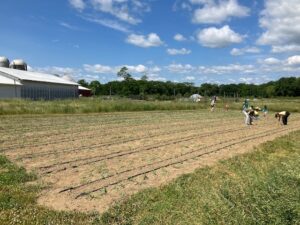
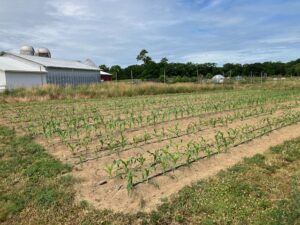
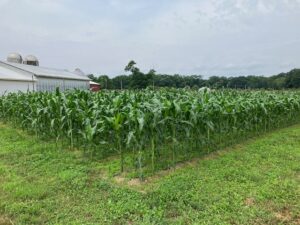
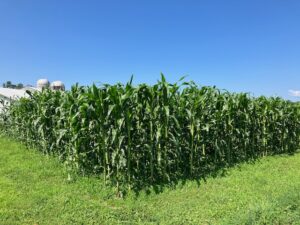
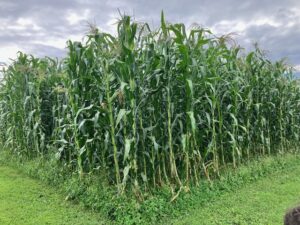
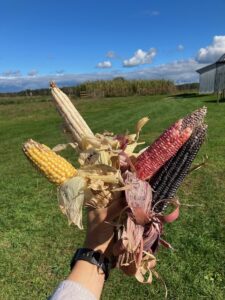
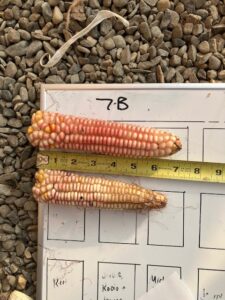
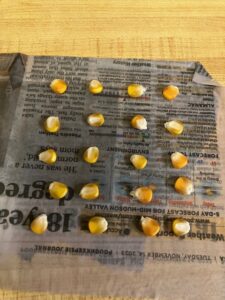
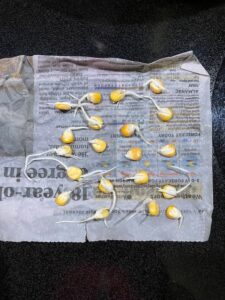
Season 3, 2024

Due to availability of corn seed varieties available for provision by the CIMMYT, a selection of 10 varieties of corn were chosen based on the success of prior season (2023) and planted in plots. This year three beds of 20 foot length were plant in two rows (120 bed feet total) for each variety. Two lines of drip tape were used for each bed and irrigation was monitored throughout the season.
A summer wind storm came through on June 29th, 2024. Most, but not all, varieties were knocked down. This was a great test for the varieties since one of the main factors limiting commercial viability is lodging. Of the varieties that got knocked down, the majority were able to right themselves over the following weeks, but a kink at the base was visible. From prior experience, I assume that had the wind storm taken place later in their development, they would not have been able to right themselves.
This last season of the trials, the winners were clear. The main factors that were taken into account were: germination/viability rate of harvested seed, dryness/maturity of plant at end of season, and lodging. In second place was variety TAMA 25, and in first place was TAMA 5. Both varieties showed very positive attributes in comparison with our control group variety (Wapsie Valley) and were superior to the other trial varieties. Most significant was their harvested seed viability rates (over 95%), lodging (0%), total plant height (around 12 ft), ear length and fill, and maturity over the course of the season (both dried down by harvest). These attributes carried over the past two seasons, even in 2023 when we had multiple wind storms. The reason TAMA 5 was considered the superior of the two was its ear length. The variety seems like a it would give a greater return in a commercial setting.
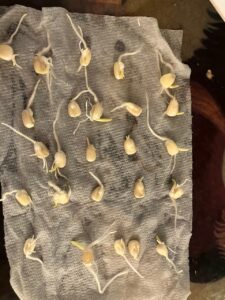
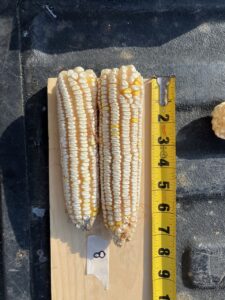
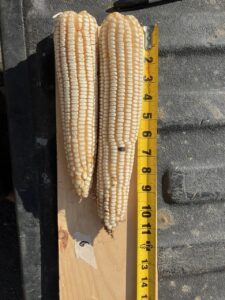
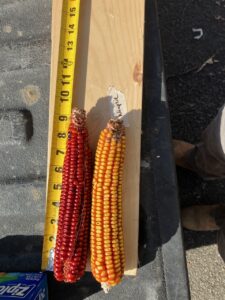
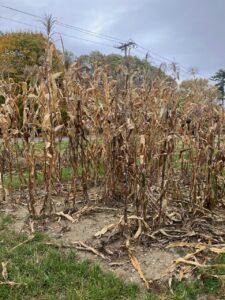
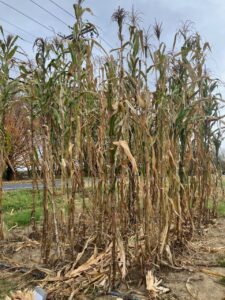

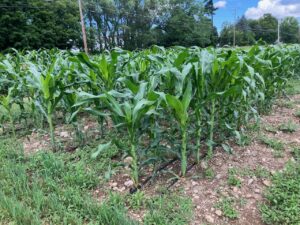
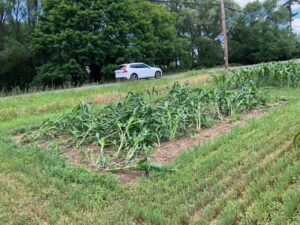
Season 3 Summary:
The trials have successfully highlighted two varieties of heritage tortilla corn that show promise for cultivation and commercial viability in New York's Hudson Valley.
The top choice was a traditional landrace corn variety from Mexico, cataloged by the CIMMYT seed bank as TAMA 5 (also known as CIMMYTMA 1948). It is a dent corn from the Mexican group of landraces known as ratón. These are adaptable varieties known for being less photoperiod sensitive. They are also used in making tortillas. The original acquisition was made in the year 1950 but the exact location is not listed.
The second place variety was a landrace called TAMA 25 (also catalogued as CIMMYTMA 412). It is also a dent of the same ratón group. This acquisition was originally collected in the northern arid region of Mexico between Nuevo Leon and Tamaulipas.
For the Future:
I was not able to isolate and manually pollinate varieties this year, thus it does not make sense to do lab analysis on kernels or draw conclusions for actual processing into tortillas. I would like to grow a single crop of TAMA 5 in the 2025 season for harvest collection, lab analysis, and processing trials to determine whether the variety excels at tortilla production under local conditions.
Education & Outreach Activities and Participation Summary
Participation Summary:
My trials took place on a piece of farmland right next to the center of my town, Red Hook NY, and on a major thoroughfare. I would regularly get farmers and passerby's stopping in to ask questions about the 18 foot tall corn I had planted. It was my pleasure to share what I was doing and learning.
I hosted one seed saving event where the corn trials were the focus. This was attended by about 15 community members, some serious about seed saving.
I also had the opportunity to host at 8 tours with various different groups. During these tours I'd take about 10 minutes to walk through the corn trials and explain the concept. Among these groups were at least 3 groups of farm apprentices from our regional CRAFT group.
Learning Outcomes
Farmers that attended the tours gained increased awareness of landrace corn varieties, photoperiod sensitivity in corn, and variety trialing.
Project Outcomes
The main takeaway is that it looks like there is a real possibility for growing Mexican landraces here in New York´s Hudson Valley. There is certainly a culinary interest in corn varieties used for tortilla production. One of the limitations of using traditional varieties of corn is transport costs. If production could occur locally at scale then there could be much wider use.
One of the limitations is photoperiod sensitivity. A good deal of the landrace varieties of corn in this trial came from Mexico and Central America. However they either took too long to mature relative to our season, or simply were not viable due to our drastically different photo period. Some varieties were not able to facilitate pollination and ear filling due to wide margins of time between silk and tassel bloom. Some varieties never put out silks at all. Other varieties were still green in November, leading to mold.
Finally, a limitation of many landrace varieties is height and susceptibility to lodging.
It appears that corn varieties from the Mexican group of "ratón" cultivars show promise for commercial cultivation here in NY´s Hudson Valley. They generally have a relatively short season, are shorter and therefore do not lodge, and are less photoperiod sensitive.
I now need to grow the top ranked variety in isolation to do accurate lab analysis of the harvest, test for culinary attributes, and produce seed stock. I plan on my own time to do a small isolated field of TAMA 5 during the 2025 season.
One of the main limitations during the trial period was my success at hand pollination and isolation. I used bagging techniques, but my ears never filled in.
I would like to work with the Glynwood Center, a local food and farming advocacy organization to further my trials. They have an active grains program which focuses on the commercialization of local and heritage breeds.
